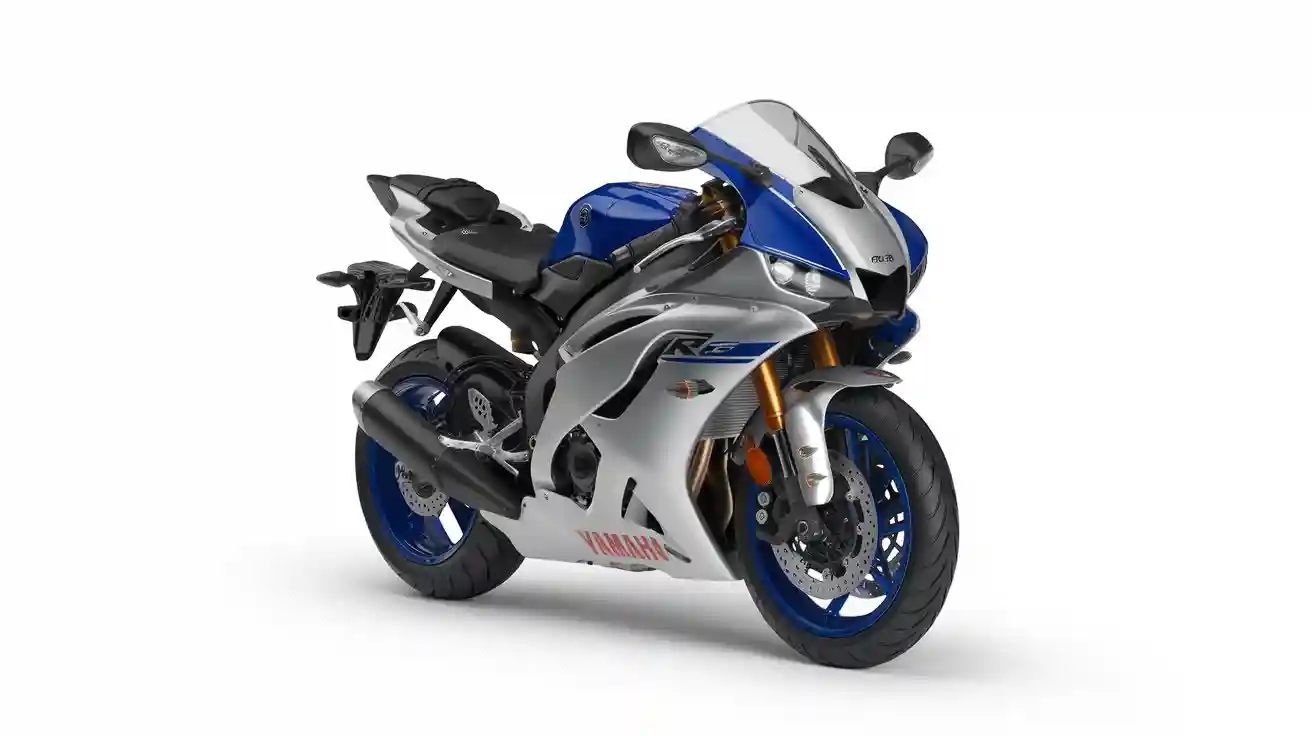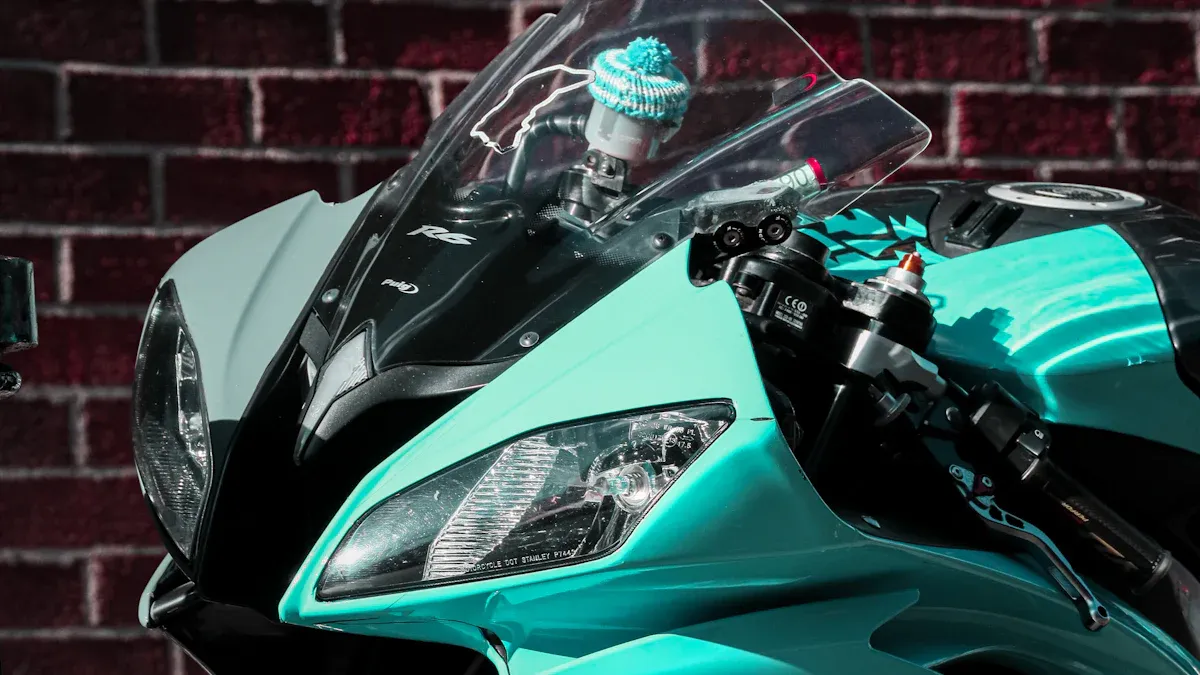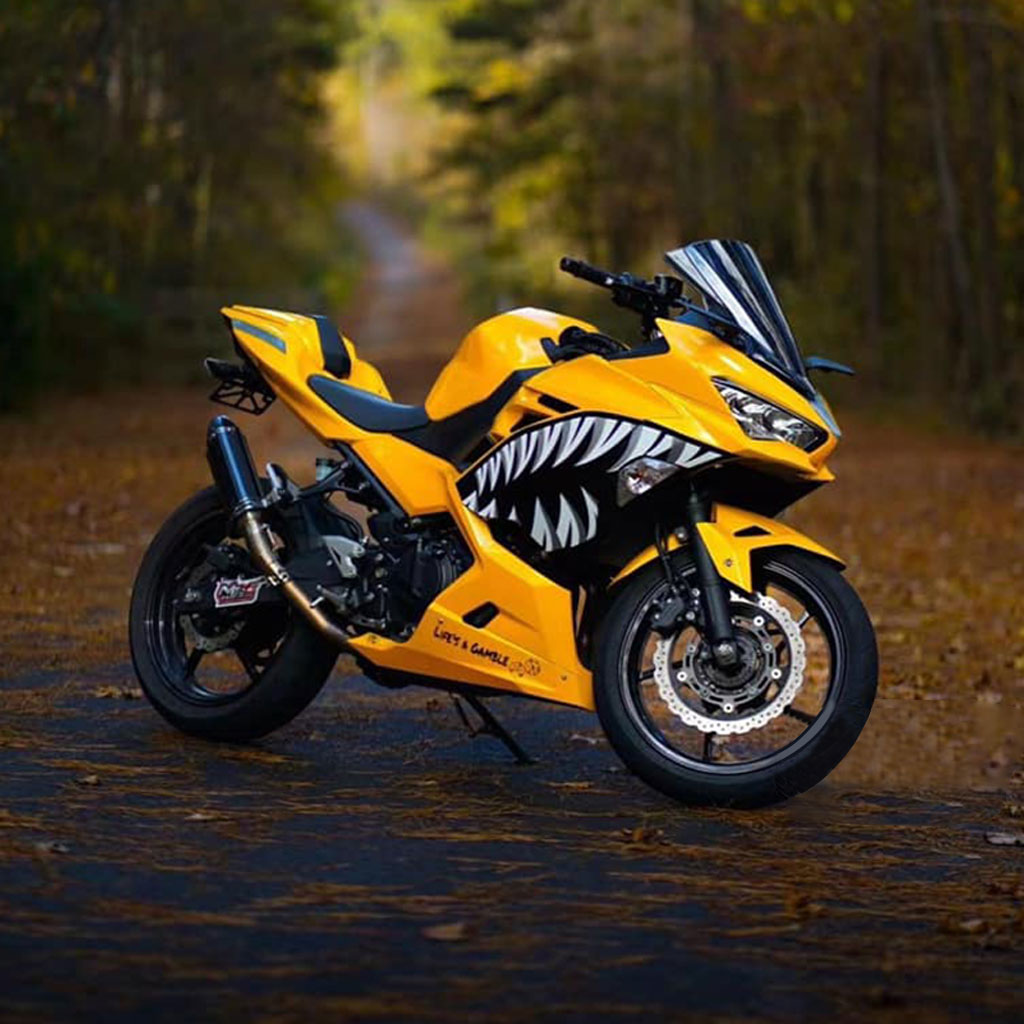Distinctive Design Features of the 2016 R6 Explained

The 2016 R6 stands out in the world of supersport motorcycles. Yamaha gave this motorcycle a sleek fairing with an aggressive look. The R6 uses a low-drag front fairing, a MotoGP-style ram air intake, and LED marker lights. Riders notice the magnesium rear subframe and aluminum fuel tank. The flat, narrow seat and cross-layered bodywork help with control and cooling. As the final third-generation YZF-R6, this Yamaha motorcycle shows how smart design can improve speed, handling, and rider confidence.
2016 Yamaha R6: The Last of the Third Generation
Defining the Third-Generation YZF-R6
Yamaha launched the third-generation YZF-R6 in 2006. This motorcycle set new standards for technology and performance. Riders noticed several features that made this generation unique:
- Yamaha introduced the first production fly-by-wire throttle system (YCC-T) for precise throttle control.
- The straight frame concept, inspired by Yamaha’s M1 GP machine, aligned the steering head, swingarm pivot, and rear axle. This design improved handling and stability.
- A racing-style slipper clutch helped riders brake and downshift smoothly at high speeds.
- The aerodynamic bodywork, with ram-air induction ducts, boosted engine performance and cooling.
- The compact 599cc DOHC inline four-cylinder engine used titanium valves and a high compression ratio, reaching up to 13.1:1.
- Yamaha added a variable length intake system (YCC-I) to widen the powerband.
- The R6 delivered up to 129bhp, with better throttle response and mass centralization than earlier models.
- Adjustable front forks and a refined rear shock allowed riders to fine-tune the suspension for track use.
These features set the third-generation YZF-R6 apart from previous motorcycles. Yamaha focused on both technology and rider experience.
Why the 2016 R6 Marks the End of an Era
The 2016 R6 became the last model of its generation for several reasons. Yamaha faced new challenges from changing regulations and market trends. Stricter emissions standards, such as Euro 5, made it hard to keep the 600cc inline-four engine powerful and lightweight. Updating the engine would have caused power loss, weight gain, and higher costs. Market demand for 600cc supersport motorcycles also dropped, making updates less practical.
The International Motorcycling Federation introduced new rules for Supersport racing. These rules shifted focus away from traditional 600cc motorcycles like the R6. Yamaha decided to discontinue the R6 after 2016, with no immediate replacement. This decision reflected both regulatory pressures and changing rider preferences. The 2016 R6 stands as the final chapter of Yamaha’s third-generation YZF-R6 motorcycles.
Distinctive Fairing Design of the 2016 R6
Unique Lines and Aerodynamic Profile
The 2016 R6 features a fairing that stands out in the world of supersport motorcycles. Yamaha engineers shaped the bodywork with sharp, angular lines. These lines give the motorcycle a fast and aggressive look, even when it stands still. The fairing hugs the frame tightly, reducing the space between the panels and the engine. This close fit helps the motorcycle cut through the air with less resistance.
The aerodynamic profile of the 2016 R6 plays a big role on the track. Riders notice how the motorcycle feels stable at high speeds. The fairing channels air smoothly around the body, which lowers the drag coefficient. This design helps the R6 reach higher speeds and improves handling during fast riding. The motorcycle’s most aerodynamic shape comes from years of Yamaha’s racing experience. The fairing not only looks sharp but also helps the rider stay in control during aggressive track sessions.
Influence from Yamaha Racing and the YZF-R1
Yamaha used lessons from its racing teams when designing the 2016 R6. The design language comes from the YZF-R1, Yamaha’s top superbike. The front fairing and side panels share a similar look with the R1. Both motorcycles use a MotoGP-style ram air intake in the center of the nose. This feature helps the engine breathe better at high speeds.
The racing influence shows in the way the fairing fits the rest of the motorcycle. Yamaha wanted the R6 to feel like a true track machine. The bodywork wraps tightly around the frame, just like the bikes used by professional racers. Riders feel the difference when they lean into corners or tuck in on straight sections of the track. The motorcycle’s design gives them confidence and control, making every riding session feel like a race.
Note: Yamaha’s focus on racing technology means the 2016 R6 shares many features with its championship-winning motorcycles. This connection makes the R6 a favorite for riders who want a track-ready machine.
Functional Airflow and Cooling Efficiency
The fairing on the 2016 R6 does more than look good. It manages airflow and cooling with great efficiency. Yamaha engineers designed the cross-layered fairing to direct air exactly where the motorcycle needs it most. This design keeps the engine cool, even during long track sessions.
- The fairing channels air through the MotoGP-style ram air intake, improving engine performance.
- The cross-layered panels guide airflow over the engine and away from hot spots.
- The design reduces aerodynamic drag by 8%, making the 2016 R6 one of Yamaha’s most aerodynamic production motorcycles.
- The improved airflow helps the motorcycle maintain top speed and keeps the rider comfortable during intense riding.
Riders on the track notice these benefits right away. The motorcycle stays cool, even under hard riding. The fairing’s design helps the R6 perform at its best, lap after lap.
Aggressive Headlight and Front Profile of the R6

Headlight Shape and Placement
The 2016 R6 features a headlight design that stands out among supersport motorcycles. Yamaha engineers gave the R6 twin projector headlights that sit low and wide on the front fairing. These headlights create a sharp, focused look. The placement helps the motorcycle appear ready for the track at any moment. Riders see the headlights as a signature feature of the R6. The lights point slightly upward, which gives the motorcycle an alert and aggressive stance.
The headlight assembly sits close to the ram air intake. This design choice keeps the front profile compact. The headlights use clear lenses and bright bulbs, which improve visibility during night riding. Yamaha made sure the headlight shape matches the aerodynamic lines of the fairing. The result is a motorcycle that looks fast and focused, even when parked.
Note: The headlight placement also helps reduce wind resistance. This feature supports the R6’s performance on the track.
Contribution to the R6’s Identity
The front profile of the R6 plays a big role in its identity. Many riders recognize the motorcycle by its aggressive face. The headlights, combined with the sharp nose and ram air intake, give the YZF-R6 a look that signals speed and power. Yamaha designed the R6 to stand out in a crowd of motorcycles. The front end looks like it belongs on a race track, not just on city streets.
On the track, the headlight design helps the rider focus. The low, wide lights keep the front end looking slim. This shape allows the motorcycle to cut through the air with less drag. Riders feel more confident when riding at high speeds. The YZF-R6’s front profile also helps with handling. The compact design keeps weight forward, which improves control during aggressive track sessions.
- The R6’s headlight and front profile:
- Make the motorcycle easy to spot at the track
- Support the aerodynamic goals of the design
- Give the YZF-R6 a lasting, memorable look
The 2016 R6 shows how Yamaha uses design to blend form and function. The motorcycle’s headlight and front profile help define its legacy in the world of supersport motorcycles.
Tail Section and Integrated Bodywork on the 2016 YZF-R6
Tail Design and Aerodynamic Integration
The tail section of the 2016 R6 shows how Yamaha focuses on both style and function. The motorcycle features a sharp, upward-swept tail that gives the R6 a race-ready look. This design helps the motorcycle cut through the air with less drag. The slim tail also reduces weight at the back, which helps the R6 feel more agile during fast cornering. Yamaha engineers shaped the tail to work with the rest of the bodywork, making sure air flows smoothly from the front to the rear.
The integrated tail light sits neatly within the tail section. This placement keeps the motorcycle’s lines clean and uninterrupted. Riders notice that the tail design not only looks aggressive but also helps with stability at high speeds. The aerodynamic shape of the tail works with the fairing to keep the R6 steady on the track. The motorcycle’s compact rear end also makes it easier for riders to move around during quick direction changes.
The tail section of the YZF-R6 stands out for its blend of style and performance. Yamaha uses sharp lines and a narrow profile to give the motorcycle a unique identity.
Cohesive Bodywork and Rider Ergonomics
Yamaha designed the 2016 R6 with bodywork that fits together like pieces of a puzzle. The panels line up tightly, creating a smooth surface that helps the motorcycle move through the air. This cohesive design reduces drag and boosts the R6’s performance. The motorcycle’s bodywork also protects the rider from wind, making high-speed riding more comfortable.
The YZF-R6 places the rider in a forward-leaning stance. Clip-on handlebars and rear-set footpegs put the rider in a position that improves control and aerodynamics. This setup works well for track riding, where riders need to shift their weight quickly. The low seat height makes it easier for riders to handle the motorcycle, even at slow speeds. The aggressive riding position can feel demanding on long rides, but it gives the rider better feedback and control during high-performance riding.
- The aerodynamic bodywork reduces drag and increases stability.
- Sharp lines and a low seat help with comfort and handling.
- Clip-on handlebars give the R6 a sporty feel and improve rider control.
The 2016 R6 shows how Yamaha balances performance and comfort. The motorcycle’s integrated bodywork and thoughtful ergonomics make it a favorite for riders who want both speed and control.
Comparing the 2016 Yamaha R6 to Previous and Later Models
Differences from Earlier R6 Generations
The 2016 R6 stands as a major step forward from earlier versions of the YZF-R6. Yamaha kept the core engine and chassis design from the 2010–2016 models, but earlier generations had different features. The table below highlights the main differences:
| Feature | 2016 R6 (2010–2016) | Earlier R6 (1999–2009) |
|---|---|---|
| Engine | 599.4 cc inline-four, titanium valves, high compression, ~122 bhp | Smaller bore, longer stroke, lower compression, less horsepower |
| Fuel System | Advanced fuel injection, YCC-T, YCC-I | Carburetors (early), basic fuel injection (later) |
| Chassis | Straight frame, improved mass centralization | Conventional frame, less focus on mass centralization |
| Suspension | Adjustable inverted forks | Conventional forks (early), less adjustability |
| Ergonomics | Refined seat and tank for comfort | Basic seat and tank shapes |
| Electronics | No traction control or throttle maps | No electronic rider aids |
The 2016 YZF-R6 offered better handling and comfort than older models. Riders found the engine more responsive. The chassis provided improved stability. The used Yamaha R6 from this era became popular for its balance of performance and reliability.
Changes Introduced in the 2017 YZF-R6 and Beyond
Yamaha introduced a major model refresh with the 2017 Yamaha YZF-R6. The new Yamaha R6 brought many updates that changed the riding experience. Key changes included:
- Complete restyling to match the YZF-R1, with sharper fairings and new headlights.
- Raised windscreen and slimmer tail section for better aerodynamics and rider comfort.
- Aluminum fuel tank replaced steel, reducing weight and improving grip.
- Magnesium rear subframe narrowed by 20mm, enhancing rider mobility.
- Suspension upgraded to 43mm KYB inverted forks and a new KYB rear shock for better handling.
- Larger 320mm front brake discs and a new Nissin master cylinder improved braking feel.
- Electronic aids added: traction control with six levels, ABS, and optional quickshifter for clutchless upshifts.
- Aerodynamic improvements reduced wind resistance by 8%, increasing top speed by about 4 mph.
The 2017 Yamaha YZF-R6 became the most advanced R6 yet. Riders noticed a more stable chassis and improved electronics. The engine felt smoother, and the motorcycle handled better at high speeds. Used Yamaha R6 models from 2017 and later gained popularity for their advanced features and rider aids. The model refresh made the R6 easier to ride and safer, while keeping its racing spirit alive.
Tip: Riders looking for a used Yamaha R6 should consider how the 2016 model compares to the 2017 Yamaha YZF-R6. The newer model offers more technology and comfort, but the 2016 R6 remains a favorite for its classic design and pure riding feel.
Impact of the 2016 R6’s Design on Performance and Legacy
Effect on Handling and Rider Experience
The 2016 Yamaha R6 stands out for its sharp handling and quick response on both road and track. Riders notice the shorter wheelbase and aggressive riding position. These features help the R6 turn quickly and make it easy to change direction in tight corners. The forward-leaning stance gives riders more control and better feedback during high-speed riding.
- The compact Deltabox aluminum frame keeps the R6 light and agile.
- The straight frame concept improves cornering precision and stability.
- The magnesium rear subframe and aluminum swingarm help with mass centralization, making the bike stable in mid-corner.
- The fully adjustable suspension allows riders to set up the R6 for different track or road conditions.
- The racing-style slipper clutch makes downshifting smooth and helps control the bike during hard braking.
Professional riders and reviewers praise the R6 for its nimble chassis and quick turn-in. The stiffer suspension and aggressive ergonomics suit riders who focus on track performance. The brakes work well but need a firm hand. Some riders find the R6 less comfortable for street use, but it shines on the track. The R6’s design supports high-speed riding and makes it a favorite for racers and sport riders.
Lasting Appeal and Collectibility of the 2016 Yamaha R6
The 2016 YZF-R6 holds a special place among Yamaha sport bikes. Its design and performance make it popular with collectors and enthusiasts. The lightweight frame, sharp styling, and proven track record add to its appeal. Riders often choose the R6 as a base for racing or custom builds. Many upgrade the suspension or add carbon fiber wheels to boost performance and reduce weight.
A table below shows why the 2016 R6 remains a top choice:
| Feature | Benefit |
|---|---|
| Lightweight chassis | Improves agility and speed |
| Aggressive styling | Gives a race-ready look |
| Proven track success | Builds a strong reputation |
| Aftermarket support | Allows easy upgrades for performance |
| Collectible status | Increases value over time |
The 2016 R6 does not have advanced electronics like a traction control system or three riding modes, but its pure riding feel attracts those who want a direct connection to the bike. Riders enjoy the challenge and reward of mastering the R6 on the track. The YZF-R6’s legacy continues as a symbol of Yamaha’s commitment to speed, handling, and performance. Many consider riding the Yamaha R6 an unforgettable experience, especially for those who value agility and track-focused design.
The 2016 r6 stands as a milestone in Yamaha’s supersport history. Industry experts highlight its aerodynamic fairing, advanced electronics, and lightweight magnesium parts. The r6 introduced features like a GP-style exhaust and ride-by-wire throttle, setting new standards for performance. As the final third-generation yzf-r6, this model marks the end of an era defined by sharp handling and racing pedigree. The r6’s design influenced later models, ensuring the yzf-r6 legacy continues. Riders and enthusiasts remember the r6 for its unmatched agility and lasting impact on the supersport class.
FAQ
What makes the 2016 Yamaha R6 special for collectors?
Collectors value the 2016 Yamaha R6 because it marks the end of the third generation. The unique design, strong performance, and limited production make it a standout choice in any yamaha r6 buyers guide.
How does the 2016 R6 compare to other years for performance?
The 2016 R6 offers sharp handling and a lightweight frame. Many riders consider it one of the best year r6 to buy for track use. It delivers a pure riding experience without advanced electronics.
Where can riders find the official specifications for the 2016 R6?
Riders can find the official yamaha yzf-r6 specifications on Yamaha’s website or in the owner’s manual. These sources list engine details, weight, and performance numbers for the 2016 model.
Is the 2016 R6 a good choice for new riders?
The 2016 R6 suits experienced riders best. Its aggressive ergonomics and high-revving engine may challenge beginners. Riders should review a yamaha r6 buyers guide before choosing this model.
What upgrades do owners often add to the 2016 Yamaha R6?
Owners often add aftermarket exhausts, upgraded suspension, and lightweight wheels. These changes improve performance and handling. Many also look for accessories that match the yamaha yzf-r6 specifications for racing.
See Also
Key Features That Highlight The 2025 Yamaha R7
Distinctive Qualities Of The 2025 BMW S1000RR Model
Reasons Yamaha R6 Fairings Are Essential Accessories
Top Yamaha R6 Fairing Kits Reviewed For Style And Performance

